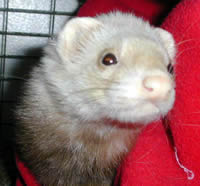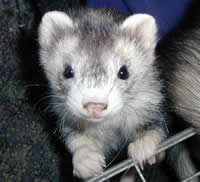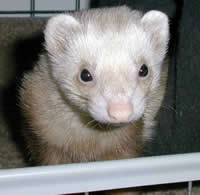| |
|
About Ferrets
HISTORY OF FERRETS:
 Mustela furo, the domestic European ferret, is
a member of the weasel family (polecat, mink, ermine, otter,
etc.). Ferrets were domesticated about 2000 years ago. The first
ferrets came to the United States over 300 years ago on ships
and were used for rodent control. Mustela furo, the domestic European ferret, is
a member of the weasel family (polecat, mink, ermine, otter,
etc.). Ferrets were domesticated about 2000 years ago. The first
ferrets came to the United States over 300 years ago on ships
and were used for rodent control.
There are no "wild" populations of ferrets in the United States, except
for the North American Black-footed
Ferret, which is an endangered species. Pet ferrets have
no hunting instincts left; they will chase and catch rodents,
but they don't know how to survive on them. There are estimated
to be over 6 million pet ferrets kept in the United States.
Ferrets are domestic in the truest sense of the word. They come
in a variety of colors (albino being the original color of ferrets)
such as: sable, chocolate, silver and cinnamon. They come in
different patterns such as: mitts, panda, badger, and siamese.
Male ferrets are referred to as hobs and average from 2 to 5
pounds. Female ferrets are called jills and average from 1 to
3 pounds. Baby ferrets are called kits and are adult size at
6-7 months. A group of ferrets are called "a business
of ferrets".
 Food and treats: Food and treats:
Ferrets need a high protein (32% or higher) diet consisting mainly
of meat or animal byproducts rather than grain. The amino acids
in vegetable protein are not readily used by a ferret's 3 hour
digestive system. Low ash and magnesium are important to a good
ferret diet as well. Quality dry cat foods are available at feed
stores, pet shops, or your veterinarian's office. Do not use
grocery store brands of cat and kitten food because the dyes,
fillers and preservatives used are not good for the ferrets and
they are low on meat protein. Foods designed for ferrets are
also good, as long as they are not fish based - most ferrets
do not care for it.
Ferrets enjoy eating treats such as raisins, grapes (peeled or
cut up), unsalted popcorn, peanut butter, banana, and an occasional
veggie or two. Try different things out in small quantities and
remember - this is a treat and not an alternative to quality
food. Avoid feeding your ferret dairy products, as they can cause
diarrhea, and do not feed your ferret chocolate or caffeine products.
The ferrets may beg for them, but they can harm your ferret.
Nail clipping and baths:
Linatone, from pet and feed stores, is good
for ferrets as a treat (2 drops a day or 1 pump a week) and
a way to occupy the ferret while clipping its nails. Place
the ferret on their back and put a little linatone (ferretone)
on the belly. Show him where it is, and while he's licking
it up, clip the nails on all four feet to within a little
bit of the quick (the pink part of the nail). Do not cut
the quick as this may result in bleeding.
Ferrets can be bathed about once a month. Any baby, kitten
or ferret shampoo will do. Bathing too often will result
in dry, itchy skin, so wash their bedding more often (about
once a week). When treating for fleas, use a kitten or
ferret shampoo with pyretherins to control fleas. Never
dip a ferret!
Vaccinations:
Ferrets require a canine distemper vaccination
each year. If the ferret has an unknown vaccination history,
the shot should be followed up in three weeks with another booster.
If the ferret is a kit, they need to go through a series
of 3 shots, the breeder or farm will have only given them
the initial shot, so follow up in three week intervals
until the series is complete. The first shot is given when
the kit is 6 - 8 weeks old, the second shot at 9 - 11 weeks,
and the third at 12 - 14 weeks. The vaccine for canine
distemper is called FERVAC-D. It is extremely important
to protect your ferret against distemper, because it is 100%
fatal in ferrets. Never use a ferret based vaccine!
A rabies vaccine for ferrets was licensed in 1990. In November
of 1997, public health veterinarians released new guidelines,
called the Compendium of Animal Rabies Control, for rabies protocol
in which the ferret is given the same protection as the dog or
cat. The vaccine to be used is called IMRAB. A vaccination can
be given as early as 3 months of age, and should be repeated
each year. Do not vaccinate for rabies and distemper at the same
time but space 2-3 weeks apart to prevent reactions to the vaccines.
Altering and descenting:
When you purchase your ferret from a pet store,
they are normally already altered and descented. If you buy
your ferret from a breeder, it may be "whole" or
unaltered/ not descented. If this is the case, you should spay/neuter
the ferret. In jills, this is in order to save their life.
A jill will stay in heat until bred, and if not spayed,
she will develop a condition called aplastic anemia and
die. In hobs, neutering will reduce the odor and the aggressiveness
of the male ferret. A "whole" male may
not get along with any other males, and will exhibit mating
behavior toward the females. Do not alter your ferret until
they are at least 6 months of age. Descenting a ferret
is not required, and should only be performed if the ferret's
scent glands are causing health problems.
Cages, ferret proofing and training:
We recommend that you keep your ferret caged or
confined to a single room while no one is home. Wire cages with
multiple levels are the preferred choice for housing ferrets.
DO NOT use aquariums and wood chips of any kind! You can
line the bottoms of the wire cage with outdoor carpet or
towels. Use water bottles versus bowls as ferrets enjoy
tipping them. A good food bowl to use is a stainless steel
bird bowl that has a bracket to hold it in place. Food
and water should always be available to the ferret.
Ferrets are inquisitive and fearless and capable of getting
into places you never imagined. If their head can fit,
the body can follow. To ferret proof your home, start with
your plants. Get them out of reach! Ferrets love to dig
in dirt. They do not climb very well generally, but they
are agile jumpers and can grip to pull themselves up or
pull objects over and down. Items such as trash cans, tablecloths,
laundry baskets, drink glasses, etc., are fair game. Ferrets
are not destructive, but they do like to toss pillows off
of sofas and steal your dirty socks and hide them under
beds. Sometimes they don't wait for you to remove your
socks, so watch your toes! Some inexpensive toys for ferrets
are: 4 inch drainage tubing; paper bags; paper boxes, old socks,
plastic milk cartons with holes in them; just use your imagination!
An occupied ferret can't get into trouble! Latex toys are a
no-no for ferrets - they can easily break off pieces
and swallow them, which can cause blockages and be dangerous.
 To discipline a ferret, a stern "NO" with a tap on the nose is usually
sufficient. If biting or nipping is a problem, there is a product called Bitter
Apple which helps in training. It tastes really awful and teaches them not to
bite. Other methods of discipline involve "scruffing" -
holding the ferret by the fold of skin in front of the shoulders.
The important thing to remember is: be consistent. If it is
inappropriate behavior now, it should always inappropriate.
Ferrets have poor eyesight, so it they can't see the litterbox,
any corner will work. We suggest that you handle the ferret
for five minutes after it awakens (at which time the ferret
may shiver while adjusting to the room temperature). Place
him back in the cage to use the litter box and then let him
out to play, or place litterboxes in strategic corners in your
house. Unlike cats, ferret urine does not have a strong smell
and if their stools are left to dry, can be picked up and tossed
in the trash the next day. Use clay litter , recycled paper
litter or sand in the box. To discipline a ferret, a stern "NO" with a tap on the nose is usually
sufficient. If biting or nipping is a problem, there is a product called Bitter
Apple which helps in training. It tastes really awful and teaches them not to
bite. Other methods of discipline involve "scruffing" -
holding the ferret by the fold of skin in front of the shoulders.
The important thing to remember is: be consistent. If it is
inappropriate behavior now, it should always inappropriate.
Ferrets have poor eyesight, so it they can't see the litterbox,
any corner will work. We suggest that you handle the ferret
for five minutes after it awakens (at which time the ferret
may shiver while adjusting to the room temperature). Place
him back in the cage to use the litter box and then let him
out to play, or place litterboxes in strategic corners in your
house. Unlike cats, ferret urine does not have a strong smell
and if their stools are left to dry, can be picked up and tossed
in the trash the next day. Use clay litter , recycled paper
litter or sand in the box.
Be careful where you sit and walk when the ferret is out
- he might be under a pillow, blanket, rug, pile of laundry,
etc. Sleep sofas and recliners are places where ferrets
can be injured in the mechanics. Block off furnaces, stoves,
refrigerators, washers, dryers and dishwashers. Do not
allow your ferrets outdoors without a leash and close supervision.
They have a bad sense of direction in large areas.
Health:
Ferrets have a very high metabolic rate and
are normally energetic and playful. We suggest a yearly visit
to the vet until the ferret is 4 years old, and then make it
twice a year. A ferret can catch and transmit the cold and
flu, so wash your hands frequently if you or the ferret is
sick to prevent passing it on. A ferret which is lethargic
or not eating and drinking needs to go to the vet. A major
concern is always dehydration. If you think your ferret
is dehydrated, mix karo syrup, honey, or linatone with
lukewarm water and get the animal to drink it and then
get the ferret to a vet. They do not tolerate extremes
in temperature well, so keep them out of direct sunlight
and make sure they have plenty of ventilation. Ferrets
can also contract heartworms from mosquitos, so ask your
vet for a heartworm preventative if you decide to house
your ferret outdoors. then make it
twice a year. A ferret can catch and transmit the cold and
flu, so wash your hands frequently if you or the ferret is
sick to prevent passing it on. A ferret which is lethargic
or not eating and drinking needs to go to the vet. A major
concern is always dehydration. If you think your ferret
is dehydrated, mix karo syrup, honey, or linatone with
lukewarm water and get the animal to drink it and then
get the ferret to a vet. They do not tolerate extremes
in temperature well, so keep them out of direct sunlight
and make sure they have plenty of ventilation. Ferrets
can also contract heartworms from mosquitos, so ask your
vet for a heartworm preventative if you decide to house
your ferret outdoors.
Ferrets are normally very healthy and make great pets.
Two are as easy to take care of as one, but more fun to
watch than a barrel of monkeys. They are great for apartment
and condo living. Ferrets live to between 6 and 9 years
and are active their entire lives. If you have any questions,
problems, or concerns, please call us. Happy ferreting!
The Ferret Haven "By-the-Sea" -- Director Lisa
Leidig
If you still have questions regarding ferrets, please go
to our FUZZY
FAQs page and see what information is there...
|
|
|
|
| Visit our Stores |


|
|
|

